One of the small issues that drive me absolutely nutty in an otherwise well put together room is when I can’t get the furniture to push all the way up against the wall. That big gap is just as ugly as leaving your toilet seats up.
The fact that I can not push this bookcase in Emma’s room up against the wall wears me out. Perhaps I pay way too much attention to things like this, but it is what it is. Nearly 100% of the time, this problem is due to those pesky AC plugs. When plugged into the wall, those plugs and their protected bases stick out almost 2 inches.
I finally decided that enough was enough, and I needed a low profile plug solution. All it took was a quick trip to Home Depot.
We bought a flat plugged extension cord, and I am now able to push the bookcase nearly all the way back to the baseboard. What a difference!
You have several different options for low profile solutions in your home. They are easy to use and make a world of difference. Here are some of my favorites:
Low Profile Plug and Cable Solutions
1. Flat Plugged Extension Cord – As shown in my example above, this option is the easiest and quickest way to work with traditional AC plugs. The profile of the flat plug is less than 1 inch, whereas a traditional AC plug takes up nearly 2 inches when plugged into the wall. This cord can be purchased at home improvement stores – mine is from Home Depot and cost $9 for a 3 grounded outlet cord.
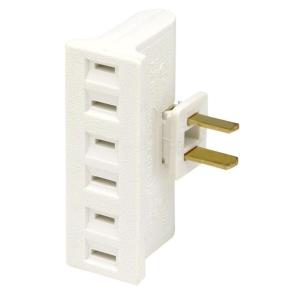 2. Triple Cube Swivel Plug – This is a cheap and useful plug when you are dealing with non-grounded plugs (i.e. 2 pronged or flat plugs). You plug the triple cube into your wall and rotate the 3 non-grounded outlets to point down. The profile of this plug is 1 inch, so it takes up about an inch of space less than just plugging a traditional AC plug into the wall. This plug can be purchased at home improvement stores for about $3.
2. Triple Cube Swivel Plug – This is a cheap and useful plug when you are dealing with non-grounded plugs (i.e. 2 pronged or flat plugs). You plug the triple cube into your wall and rotate the 3 non-grounded outlets to point down. The profile of this plug is 1 inch, so it takes up about an inch of space less than just plugging a traditional AC plug into the wall. This plug can be purchased at home improvement stores for about $3.
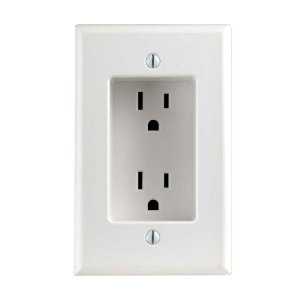 3. Recessed Outlet – If you are electrically inclined, replacing your standard outlet with a recessed outlet is another option. Traditionally used for home theaters (like recessing your power cords behind a flat screen TV), this outlet works great behind a piece of furniture. The recessed portion is almost an inch deep in the above recessed outlet ($8 at Home Depot), but you may be able to find deeper recesses if you look online.
3. Recessed Outlet – If you are electrically inclined, replacing your standard outlet with a recessed outlet is another option. Traditionally used for home theaters (like recessing your power cords behind a flat screen TV), this outlet works great behind a piece of furniture. The recessed portion is almost an inch deep in the above recessed outlet ($8 at Home Depot), but you may be able to find deeper recesses if you look online.
 4. Male to Female Right Angle Adapter – Another cord issue you may have behind a piece of furniture is the annoying coaxial cable. Your cable signal is greatly effected by how tightly you are able to screw in the cable to the receptacle. With a right angle adapter, you can screw your coax into the receptacle in such a way so that your can get it tight and there is no pressure on it from trying to push a piece of furniture back to the wall on top of it. We used this same adapter (purchased for under $2 at Altex) in our bedroom, and we were able to push the dresser where our TV sits about 2 inches closer to the wall.
4. Male to Female Right Angle Adapter – Another cord issue you may have behind a piece of furniture is the annoying coaxial cable. Your cable signal is greatly effected by how tightly you are able to screw in the cable to the receptacle. With a right angle adapter, you can screw your coax into the receptacle in such a way so that your can get it tight and there is no pressure on it from trying to push a piece of furniture back to the wall on top of it. We used this same adapter (purchased for under $2 at Altex) in our bedroom, and we were able to push the dresser where our TV sits about 2 inches closer to the wall.
Do you think any of these options help you keep a low profile behind your furniture? What other solutions do you use?
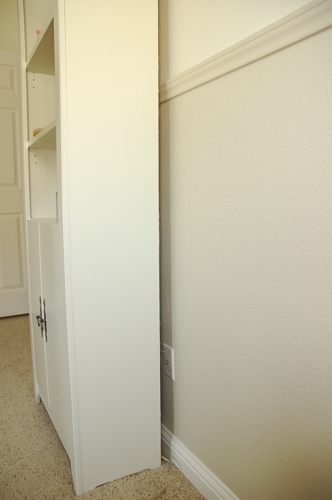
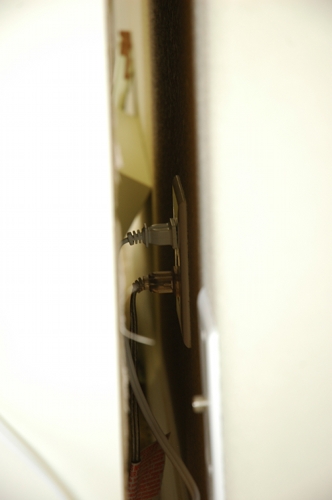

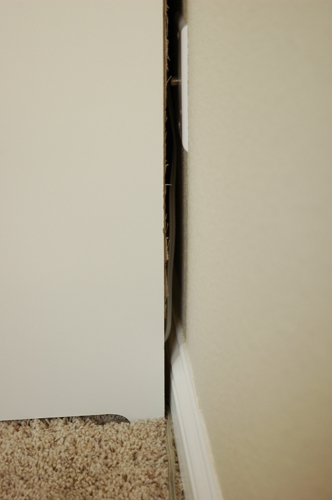
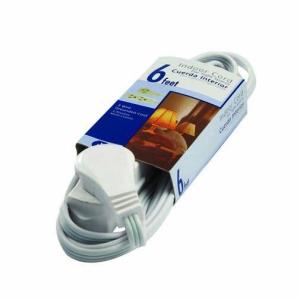
Great ideas I knew nothing about! Thanks for sharing. My big issue is tripping over wires because I don’t want to have to put all of my furniture along the walls and I dislike overhead lights. Oh for wireless lamps!
🙂
OH, I thot I was the only one! Cords drive me to the fray of my last nerve! I have used extension cords and then try to tuck them under the base board so I can see them either. I think the best solution I ever saw were plugs in the floor. It was breath taking. They even had matching covers for when they weren’t in use. Luxury. 🙂 I love your solutions. <3
There are a few places in my house where I have the same problem, but I never would have thought that I could get a flatter plug until you mentioned it! Now I realize, I actually HAVE a few of those flat extension cords already! Ha! Thanks for the tips!
I love low-profile plugs. My husband has even re-wired some of our lamps with them so that we’re not stuck using an extension cord when one isn’t needed.
Those right angle coax cable adapters are worth their weight in gold! You can get a 5-pack for under $5 here.
And for those situations where you have power outlets covered with heavy furniture, an extension cord with a foot switch (like these) can be a really handy thing! I believe the ones I linked to do, but not all of these have low profile (flat) plugs, so shop wisely.
One other thing we really love, altho not specifically for the low-profile nature, are digital electrical timers (like these). We have 3 lamps in our house that are set to automatically turn on & off at set times, which saves a lot of fumbling for hard to reach switches under lampshades. Works especially well for a lamp we have in our entry/hallway that I have set to come on at 6 A.M. when I rambling through the dark house towards the kitchen to make coffee. That same timer turns that lamp back on at 8 P.M. and keeps it on until midnight. Paired with a high-efficiency bulb, the power usage is minimal and it makes it easier to find our way back to the bedroom at the end of the day.
It totally makes a difference. You know obviously no one else notices these things, but we all notice these things in our own home. Thanks for sharing.
Sigh! My floors are crooked so I have some leaning towers of bookshelves & a cabinet in living room. I bet you’d faint at my house. Can’t hardly shove things under the front legs to fix the problem, either. Love your hints here, very handy.
Thanks for the information. I’m in Home Depot/Lowes all the time and never thought to look for a low profile plug. Guess this means we’re unloading the bookcases again. c.Joy
Hi there-great site, and yes, the ‘gap’ does bother me, too. Like Karen, my walls seem to be not exactly level, and things are not completely flush, but that’s life. Low profile plugs are a great tip, thanks!
I hope that you will anchor the bookcase so that it does not fall on a child if they climb on top of it. I say this because I knew of a child that died as a result of climbing on a dresser, and it fell on top of her. Not to be depressing here, sorry–but ever since that I see them as potential hazards unless properly anchored to the wall.
I could use one of those flat plug adapters. The gap bothers me too!
Ditto what Margaret said! I was just sure that our large bookcase set was safe but sure enough, we found our toddler scaling it like a ladder early one morning. Fortunately, my wife had insisted that I anchor it to the wall with a sturdy “L” bracket a few months earlier…